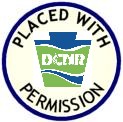
EARTHCACHE REQUIREMENTS
Each cacher must send his/her own answers BEFORE logging a find. Enjoy the journey (learning adventure) as well as the destination (smiley earned). Remember to take only pictures and leave only footprints. To get credit for this Earthcache, complete the following tasks:
SUEDBERG FOSSIL SITE
1. MESSAGE …. DIG ... a. Describe the matrix (rock). b. What tools (if any) did you use?
2. MESSAGE …. FOSSILS ... a. How much time did you spend searching for fossils? ... b. How many did you find?
There is a picnic table here for breaking large rocks to discover any treasures hidden within.
Be respectful and take only a very few fossils. We would not want this site to go the way of the Swatara Gap site.
3. MESSAGE …. IDENTIFICATION ... What fossils did you find? Use the picture to help you identify your finds.

SWATARA GAP FOSSILS
4. MESSAGE Based on the reading ... a. What period were these fossils from? ... Name two fossils found here but not at the Suedberg Fossil Site.
5. MESSAGE Fossils from two different geologic periods were found in close proximity. Hypothesize (scientific or creative) how this could occur.

LOG …. Post a picture of you or your signature item at one of your finds. This picture is your log signature.
OPTIONAL - Please respect the time and effort involved in creating this earthcache by adding A and B to your log.
A. JOURNEY OF THE MIND ... Science explains what we observe. Relate (in your own words) something you found interesting in the reading. This adds to your learning adventure and your log.
B. JOURNEY OF THE HEART ... Art shares our personal experience of what we see. Share something special you found on site, and why it is special to you. This is a memorable addition to your log and will make other hearts smile.
Journeys of Heart and Mind ...
Stories to Touch the Heart and Puzzles to Challenge the Mind / Rainbow Tree Story
THANK YOU Chris Houck for permission to share this earthcache.

MATRIX
The rock the fossils are embedded in is called the matrix. This can vary from soft to hard.
SOFT - you can use your fingers and a brush to extract the fossils.
HARD - use of a tool is needed to extract the fossils.
SUEDBERG FOSSIL SITE
During the Middle Devonian (375 million years ago), a mountain building phase began when Avalon (ancient) collided into eastern North America (modern). This collision created the Acadian Mountain range. Rivers filled with sediments flowed into the Catskill Basin at the base of the mountains. The basin was flooded by the Kaskaskia Sea, which covered many states east of the Mississippi down to the gulf of Mexico.
These sediments accumulated and formed the rock layers seen today. They show that this site was a shallow sunlit seafloor where mostly filter-feeding organisms thrived in the gentle sea currents. The Suedberg Fossil Site is located in the eastern section of the park. The borrow pit (area where soil/gravel/sand has been dug for use at another location) exposes a sequence of olive-gray siltstones and claystones called the upper Mahantango Formation. These ancient rocks are a record of a past environment.
SWATARA GAP FOSSILS
Just a short distance away, fossils from a different period were found. Unfortunately, some over zealous fossil hunters caused the site to be declared off-limits. Too bad the few ruin it for the many! See The Swatara Gap Fossil Migration
In Late Ordovician time (440 million years ago) this location had the special environmental conditions required to support abundant animal life and preserve a record of that life in the rock materials that were deposited. There are very few other accessible fossil sites in the Martinsburg Formation, even though it underlies large portions of several counties (Franklin to Northampton). Other locations were not suitable for the formation of fossils due to adverse environmental conditions such as excessive mud, turbulence, and shortage of food. The seawater itself may have selectively dissolved the shells and skeletal remains of the animals before they could be buried.
ROCK-WATER RELATIONSHIP
The most common method of fossilization is called permineralization, or petrification. After an organism's soft tissues decay in sediment, the hard parts are left behind. Water seeps into the remains, and minerals dissolved in the water seep into the spaces within the remains, where they form crystals. These crystallized minerals cause the remains to harden along with the encasing sedimentary rock.
In another fossilization process, called replacement, the minerals in groundwater replace the minerals that make up the bodily remains after the water completely dissolves the original hard parts of the organism.
RESOURCES ,,, Swatara State Park, Lebanon and Schuylkill Counties—Geologic features and fossil sites. Trail of Geology 16-016.0 ... http://www.docs.dcnr.pa.gov/cs/groups/public/documents/document/dcnr_20032568.pdf